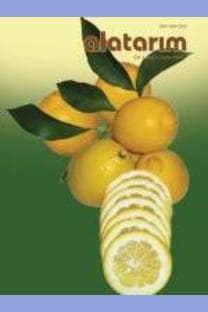A Research on Adaptation of Goji Berry (Lycium barbarum L.) in the Konya Conditions
Kurt Üzümü'nün (Lycium barbarum L.) Konya Ekolojik Şartlarında Adaptasyonu Üzerine Bir Araştırma
___
Amagase, H., Nance, D.M., 2008. A randomized, double-blind, placebo- controlled, clinical study of the general effects of a standardized Lycium barbarum (Goji) Juice, GoChi, Journal of Alternative and Complementary Medicine, 14 (4), 403-412.Anonymous, 2019. Chinese Wolfberry, http://www.china.org.cn/travel/Ningxia/2 019-01/12/content_21714118.htm:
Bucheli, P., Gao, Q., Redgwell, R., Vidal, K., Wang, J., Zhang, W., 2011. Biomolecular and Clinical Aspects of Chinese Wolfberry, In: Herbal Medicine, Eds, p. 289-314.
Fukuda, T., Yokoyama, J., Ohashi, H., 2001. Phylogeny and biogeography of the genus Lycium (Solanaceae): inferences from chloroplast DNA sequences, Mol Phylogenet Evol, 19(2): 246-258.
Karaçalı, İ., 2009. Bahçe Ürünlerinin Muhafaza ve Pazarlaması, Ege Üniversitesi Ziraat Fakültesi Yayınları, 494.
Levin, R.A., Miller, J.S., 2005. Relationships within tribe Lycieae (Solanaceae): paraphyly of Lycium and multiple origins of gender dimorphism, American Journal of Botany, 92(12): 2044-2053.
Lu, W., Jiang, Q., Shi, H., Niu, Y., Gao, B., Yu, L., 2014. Partial least-squares discriminat analysis dierentating chinese wolfberries by uplc-ms and flow injection mass spectrometric (FIMS). J. Agric. Food Chem. 62(37): 9073-9080.
Mencinicopschi, I.C., Balan, V., 2013. Scientific substantiation for the introduction, on Romanian territory, of Lycium barbarum L.: A species with sanogene properties, AgroLife Scientific Journal, 2: 95-102.
Oğuz, H.İ., Erdoğan, O., 2016. A study the development performances of Goji Berry (Lycium barbarum L.) varieties, Fresenius Environmental Bulletin, 25(12):5581- 5586.
Oğuz, H. İ., Erdoğan, O., Karaşahin, Z., Gökdoğan, O., 2019. Determining the morphologic, yield and phytochemical properties of 'Damaye' and 'NQ-7' goji berry varieties under semi-arid climate conditions, Erwerbs-Obstbau, 61: 225- 230.
Pearson, D., 1976. The chemical analysis of foods 7th ed. Churchill Livingstone: 6- 14, 200-222.
Yan, Y., Zhang, X., Jabbar, S., Abid, M. , 2014. Nutritional, phytochemical characterization and antioxidant capacity of Ningxia Wolfberry (Lycium barbarum L.), Journal- Chemical Society of Pakistan, 36: 1079-1084.
- ISSN: 1304-2653
- Yayın Aralığı: 2
- Başlangıç: 2015
- Yayıncı: Alata Bahçe Kültürleri Araştırma Enstitüsü
A Research on Adaptation of Goji Berry (Lycium barbarum L.) in the Konya Conditions
Minimum İşlenmiş ‘Katırbaşı’ Nar Çeşidinin Soğukta Muhafazası
Elif ÇANDIR, AHMET ERHAN ÖZDEMİR, Tugay GÖV, Aslıhan KANAK, Huriye ÖZÇELİK
Kurt Üzümü'nün (Lycium barbarum L.) Konya Ekolojik Şartlarında Adaptasyonu Üzerine Bir Araştırma
Şenay KARABIYIK, Ahmet Burak ÇAĞLAR, Nesrin KARATAŞ, Sinan ETİ
Celil TOPLU, AHMET ERHAN ÖZDEMİR, Elif ÇANDIR, ERCAN YILDIZ
Karpuz Melezlerinde Tohum Kabuk Rengi Kalıtımının Belirlenmesi
